- Learn about HVAC foil tape
- HAVC Aluminum Foil Tape Typical Alloy
- Advantages of HVAC aluminum foil tape in practical applications
- The Versatility of HVAC Foil Tapes
- HVAC Aluminum Foil Tape Applications
In the world of HVAC systems, the pursuit of efficiency and reliability is a constant journey. Aluminum foil tape plays a vital role among the many components that help your heating, ventilation, and air conditioning (HVAC) system run seamlessly
Learn about HVAC foil tape
HVAC foil tape is a tape specifically designed for use on heating, ventilation, and air conditioning systems. Its main purpose is to seal joints and seams in ductwork, ensuring airtight connections and preventing air leaks. The unique properties of aluminum foil make it an ideal material for this application.

HAVC Aluminum Foil Tape Typical Alloy
Common alloys used specifically for foil tapes are actually 1235 and 8011.
1235 Aluminum Foil Tape
- Properties: Alloy 1235 is known for its high purity and excellent formability. It is often chosen for applications that require a combination of flexibility and strength.
- Application: Aluminum foil tape made from 1235 alloy is commonly used in the HVAC industry to seal seams and seams in ductwork due to its malleability and adaptability to irregular surfaces.
8011 Aluminum Foil Tape
- Properties: Alloy 8011 is another popular choice for aluminum foil tape due to its combination of strength and flexibility. It is also corrosion-resistant and has good thermal conductivity.
- Application: Aluminum foil tape made of 8011 alloy is widely used in the insulation industry and HVAC systems. This alloy is favored for its ability to withstand a variety of environmental conditions.
These alloys 1235 and 8011 are tailored for applications such as aluminum foil tapes where flexibility, strength and corrosion resistance are critical.
Advantages of HVAC aluminum foil tape in practical applications
1. Improve indoor air quality
Prevent contaminants from penetrating: Sealing ductwork with foil tape prevents dust, contaminants, and allergens from entering the HVAC system. This in turn helps improve indoor air quality, creating a healthier and more comfortable environment for occupants. The tape acts as a barrier, ensuring only clean, conditioned air circulates within the system.
2. Cost-effective solutions
Long-term durability: The durability and longevity of aluminum foil tape can help save money over the life of your HVAC system. It is resistant to corrosion, fire and wear, reducing the need for frequent replacement and repairs, thereby minimizing maintenance costs. An initial investment in high-quality aluminum foil tape results in long-term reliability and cost-effectiveness.
3. Comply with standards
Meet regulatory requirements: Many building codes and standards require the use of approved materials in HVAC installations. Aluminum foil tapes that meet these specifications ensure compliance with regulatory requirements. Not only does this protect against potential legal and security issues, it also demonstrates a commitment to industry best practices.
4. Fire resistance
Enhanced Safety Measures: Fire safety is a key consideration for HVAC systems. Aluminum foil tape is made from non-flammable material and adds an extra layer of safety to HVAC installations. Using aluminum foil tape helps create a fireproof seal that prevents the spread of flames through the duct system. This enhances the overall safety of the HVAC system and surrounding environment.

The Versatility of HVAC Foil Tapes
1. Airtight sealing
Improve energy efficiency: The primary purpose of HVAC foil tape is to create an airtight seal at joints and seams in ductwork. This prevents air leaks, ensuring conditioned air reaches its intended destination without wastage, resulting in a more efficient HVAC system. This increased efficiency means lower utility costs and reduced environmental impact.
2. Flexible and comfortable
Adaptability to Various Surfaces: Unlike rigid alternatives, foil tape is flexible in nature and can easily adapt to irregular surfaces. This flexibility is particularly advantageous when sealing seams and joints in ductwork, allowing for a tight and strong bond even on contoured surfaces. The tape’s adaptability ensures a seamless and air-tight seal, helping to improve the overall efficiency of your HVAC system.
3. Quick and easy installation
Saves time and labor: HVAC professionals value the ease of application of foil tape. Its lightness and flexibility simplify the installation process, reduce labor costs and save valuable time. This fast and efficient application is especially important for the installation, repair and maintenance of HVAC systems.
4. Compatibility with insulation
Optimized insulation properties: Aluminum foil tape is often used in combination with insulation materials to form a protective sheath. This enhances the durability of the insulation system, provides resistance to external factors and helps save energy. Aluminum foil tape's compatibility with a variety of insulation materials makes it a versatile choice for enhancing overall insulation performance.
HVAC Aluminum Foil Tape Applications
Sealing Duct System Joints: The primary function of aluminum foil tape is to create a strong seal at the joints and seams of your duct system. Whether it’s a residential, commercial or industrial HVAC system, ensuring airtight connections are critical for optimal energy efficiency and temperature control.
Insulating Sheathing: Aluminum foil tape is often used in combination with insulation materials to form a protective sheathing. This enhances the durability of the insulation system, provides resistance to external factors and helps save energy.
Repairs and Maintenance: If your ductwork is damaged or worn, aluminum foil tape can serve as a quick and effective repair solution. Its adhesive properties and durability make it a reliable choice for solving problems quickly, minimizing downtime and maintaining system efficiency.
HVAC System Installation: During the initial installation of an HVAC system, foil tape is used to secure and seal various components. Its versatility and compatibility with different materials make it an integral part of the installation process.


